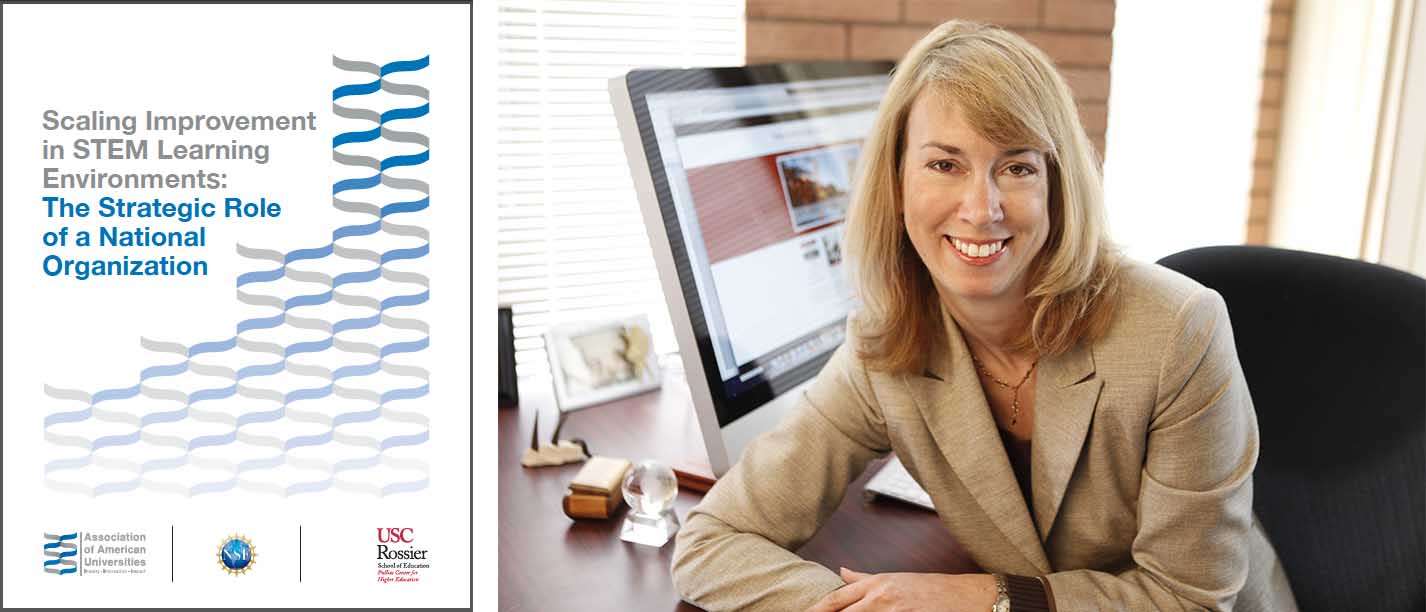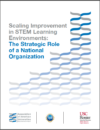
How to improve college STEM education on a national level
A new report by Pullias co-director Adrianna Kezar shows how to scale improvements in STEM learning.
Student-centered, evidence-based, and effective. Those are the qualities of best teaching practices that have been touted by STEM education experts for years. Yet still today, many professors have not adopted such practices in their classrooms, and STEM instruction has been reforming at a snail’s pace.
But what if a national higher education organization could push colleges and universities across the country to adopt these best practices en masse?
That, in short, is what the Association of American Universities (AAU) sought to do at its 62 member universities through its Undergraduate STEM Education Initiative. And this week, a report assessing AAU’s efforts was released. “Scaling Improvement in STEM Learning Environments: The Strategic Role of a National Organization” highlights AAU’s many successes in scaling reforms of undergraduate STEM teaching and learning—and identifies ways AAU could become even more effective in working with its members.
“AAU’s most effective roles in improving STEM undergraduate teaching are based on leveraging its influence,” wrote Adrianna Kezar, USC Pullias Center for Higher Education’s co-director and the author of the report. “As an organization representing leading U.S. graduate-level universities, AAU can influence the values and priorities operating across the higher education enterprise.”
Kezar’s report came out of an independent assessment of AAU’s efforts through a National Science Foundation-funded study called Scaling STEM Reform. This latest publication details the approaches and strategies AAU employed to foster and accelerate change, spurring more institutions and instructors to adopt newer STEM instructional practices. One method was using framing and messaging strategies to emphasize the value of teaching in higher education.
“For example, AAU developed language to enhance the prestige of teaching by making its members ‘as excellent in teaching as they are in research,'” Kezar explained in the report. “This frame aligned with the existing values and priorities (‘excellence’ as a desirable standard in research universities) of its target audience. Because of AAU’s expansive network and influence, the frame has been widely adopted, prompting the beginning of a shift in institutional logics.”
The report also points to future steps that could be taken—both by AAU and other national organizations—to make progress toward achieving the widespread improvement in the quality and effectiveness of undergraduate STEM teaching.
“Although the study provides important feedback for AAU to hone its strategy, larger lessons about the role of national organizations in reforming undergraduate education also emerged,” Kezar wrote. “The concepts of mapping strengths and capabilities, having concrete plans about influence, optimizing networks, and practices for maximizing learning are likely transferable to these other settings. Furthermore, many of the principles that emerged could also be utilized in regional or local organizations.”
This report is part of Kezar’s ongoing research on STEM reform and institutional culture and change.

Scaling Improvement in STEM Learning Environments: The Strategic Role of a National Organization
Adrianna Kezar (2018)
This capstone report of the Scaling STEM Reform study evaluates the national organization Association of American Universities' role in improving undergraduate STEM education at its member institutions.
A joint publication between the Association of American Universities and the Pullias Center, the report details and assesses the AAU's efforts to accelerate and scale changes in STEM education at research universities through its Undergraduate STEM Education Initiative, as well as point to future steps that could be taken---both by AAU and other national organizations---to make progress toward achieving the widespread improvement in the quality and effectiveness of undergraduate STEM teaching.
Categories: STEM Reform
stem
Download 1.34 MB 15031 Downloads
Kezar, A. (2018). Scaling improvement in STEM learning environments: The strategic role of a national organization. Washington, DC and Los Angeles, CA: Association of American Universities and Pullias Center for Higher Education.
This project is funded by a three-year grant from the Improving Undergraduate STEM Education program within the Department of Undergraduate Education of the National Science Foundation, under Grant No. NSF DUE-1432766.